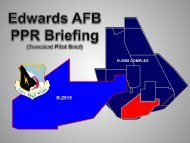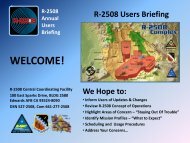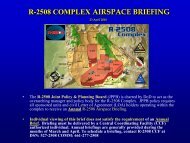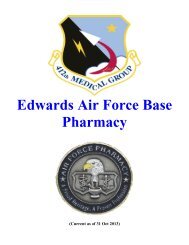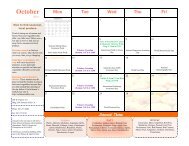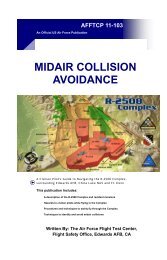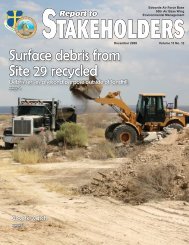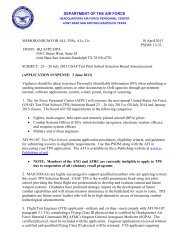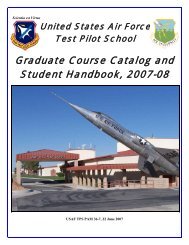AF Plant 42 AICUZ Study - Feb. 2012 - Edwards Air Force Base
AF Plant 42 AICUZ Study - Feb. 2012 - Edwards Air Force Base
AF Plant 42 AICUZ Study - Feb. 2012 - Edwards Air Force Base
Create successful ePaper yourself
Turn your PDF publications into a flip-book with our unique Google optimized e-Paper software.
maintenance depot for B-2 Stealth Bomber test and inspection.<br />
Because of the transitory nature of the missions of each tenant on<br />
<strong>Plant</strong> <strong>42</strong>, the number and type of aircraft stationed at <strong>Plant</strong> <strong>42</strong> is<br />
highly variable. Both the aircraft manufacturers and NASA have<br />
some permanently assigned aircraft used for training and<br />
transportation. In addition to these aircraft, they also support various<br />
other airframes for a range of timeframes during their final assembly<br />
and acceptance testing, or for depot maintenance and inspection<br />
period.<br />
Predominant <strong>Air</strong>craft Types Using <strong>Plant</strong> <strong>42</strong><br />
The RQ-4 Global Hawk is a high-altitude, long-endurance unmanned<br />
aircraft system (UAS) with an integrated sensor suite for worldwide<br />
intelligence, surveillance, and reconnaissance (ISR) capability.<br />
Global Hawk began as an Advanced Concept Technology<br />
Demonstration in 1995 and was determined to have military utility for<br />
providing evolutionary high-altitude, long-endurance ISR capability.<br />
It was first deployed operationally in November 2001 to support the<br />
global war on terrorism. Mission parameters can be programmed into<br />
the RQ-4 enabling it to autonomously taxi, take off, fly, and loiter<br />
above an area to gather intelligence, return, and land. Ground-based<br />
operators monitor and can update/change mission parameters during<br />
flight if required.<br />
The B-2A Stealth Bomber was first rolled out of Northrop’s assembly<br />
facility in Palmdale, CA on November 22, 1988 with its first flight<br />
occurring on July 17, 1989. It is designed for multiple missions such<br />
as deep strike penetration against heavily defended targets. It uses<br />
sophisticated low-observable technologies to give the aircraft a very<br />
low radar cross section, has an unrefueled range of greater than 6,000<br />
miles, carries a 40,000 lb payload, and delivers near-precision<br />
munitions. The B-2A has four General Electric F118-GE-100 (nonafterburning)<br />
turbofan engines, each producing 17,300 lbs of thrust.<br />
The U-2S Dragon Lady is a single seat, single engine aircraft that<br />
provides high-altitude/near space reconnaissance and surveillance. Its<br />
long and narrow wings give it glider-like characteristics allowing it to<br />
attain unmatched altitudes and loiter there for extended periods of<br />
time. The U-2 is capable of obtaining a variety of imagery such as<br />
multi-spectral electro-optic, infrared, and synthetic aperture radar<br />
products which can be stored or sent to ground exploitation centers.<br />
In addition, it also supports high-resolution, broad-area synoptic<br />
coverage provided by the optical bar camera. A lightweight, fuel<br />
efficient General Electric F118-101 engine powers the U-2, and<br />
RQ-4 Global Hawk<br />
B-2A Stealth Bomber<br />
U-2S Dragon Lady<br />
2-8



